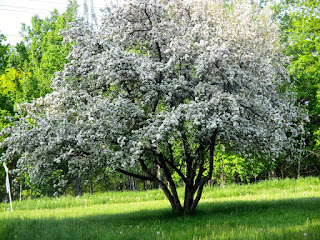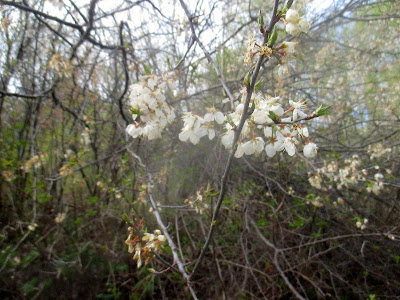 |
| WILD PLUM BUSHES... |
 |
| JUNEBERRY BLOSSOMS AND EMERGING LEAVES (note srap-like petals, reddish young leaves) |
 |
| ... WILD PLUMS IN FULL FLOWER... |
 |
| ... VERY THORNY! |
Wednesday, 8:00 AM. 52 degrees F at the ferry dock, 50 on the back porch. Wind NW, mostly calm with light gusts. The sky is nearly clear, the humidity 69%. The barometer is rising, now at 29.64". Temperatures will rise into the low 70's today through Friday with clear skies, then temperatures will plummet into the 50's with thunderstorms on Saturday, followed by continued cool temperatures and mixed skies during the week. It really looks like spring today.
I'm still without my pocket camera, so these photos are from last year. The wild plums have been blooming several days now, and are a week to ten days later than last year, more evidence of our late spring, if indeed any was needed.
Wild plums and cherries bloom right after the Juneberries, and now
the white blossoms all mingle together in the northern landscape. The
flowers are quite different when viewed closely, however; the plums and
cherries having prominent anthers that reach far above the petals.
Also, the Juneberry leaves appear with the flowers, while the flowers of
most of the wild plums and cherries appear well before the leaves. The
wild plums have thorns, the Juneberries and cherries do not.
We have two native wild plums in Wisconsin, Prunus nigra, Canada wild plum, and Prunus americana, American
wild plum. Both can form large thickets on woods edges and along
roads. Both are native to much of North America except the far northwest
and south west. The Canada plum usually is more northerly in
distribution. I am not sure which is pictured, as the leaves and fruit
are an identification characteristic and neither have yet appeared.
Both species bear fruit good to eat fresh or make preserves of if one can out-compete the bears, raccoons and birds. Canada wild plum fruit is bright red, American wild plum fruit is yellow. Bears will simply tear down branches to get the ripe fruit.
Careful of those thorns. Harvesting wild plums is another blood sport!
Both species bear fruit good to eat fresh or make preserves of if one can out-compete the bears, raccoons and birds. Canada wild plum fruit is bright red, American wild plum fruit is yellow. Bears will simply tear down branches to get the ripe fruit.
Careful of those thorns. Harvesting wild plums is another blood sport!













































